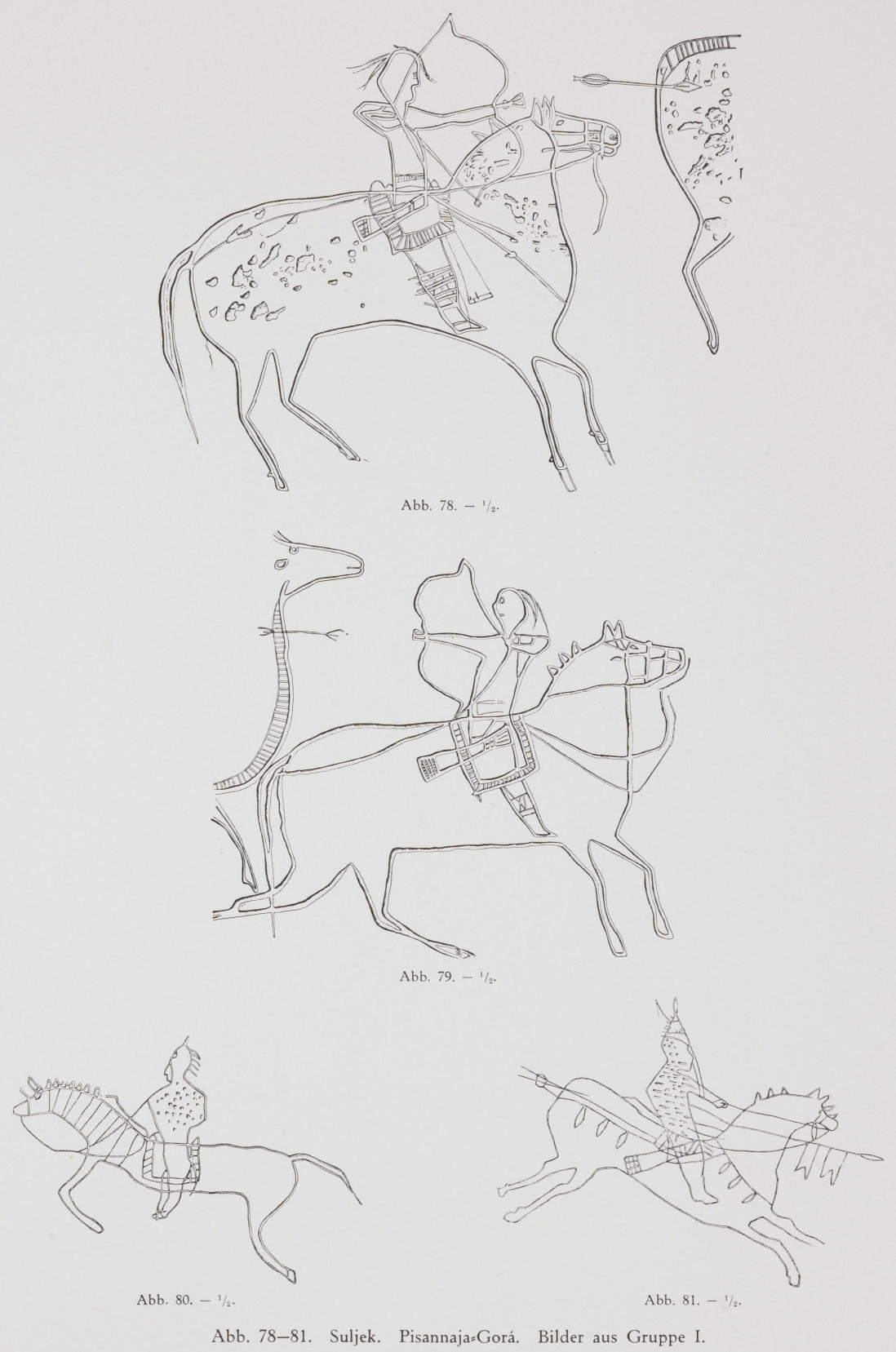
Register a SNAP EBT card with Amazon
Details of Rock Carvings on Pisannaja-Gorá, near Suljet, Siberia
Figs. 78-81
Source: Figures 78-81, Appelgren-Kivalo, Hjalmar. “Alt-Altaische Kunstdenkmäler Briefe und Bildermaterial von J. R. Aspelins Reisen in Sibirien und der Mongolei 1887-1889.”
|
1) Aus der untersten Zone. Links: der nach vorne schiessende Reiter nebst einem Pfeil in den Lenden eines gehörnten Tieres, Abb. 78; der rückwärts schiessende Reiter nebst einem Pfeil im Halse desselben Tieres, Abb. 79; der über ihnen befindliche in Helm und Panzerhemd gekleidete Reiter, Abb. 80. In der Mitte derselben Zone neben dem russischen Kreuz: der mit Helm und Panzerhemd angetane Reiter, der eine mit Fähnchen versehene Lanze vor sich hält, Abb. 81, und ein anderer Reiter, dessen Pferd in bemerkenswerter Weise geschmückt ist, Abb. 82, sowie, nahe der Felsspalte, der knieende Bogenschütze, Abb. 83. 2) Aus der mittleren Zone. In der Mitte: zwei Kamele, zwischen welchen sich ein zweirädriges Fuhrwerk befindet, auf welchem eine vollständig überdachte viereckige Hütte steht ; auf der dem Betrachter zugewandten rechten Seite des Häuschens ist eine viereckige Fensteröffnung und auf der Rückseite offenbar eine ebensolche. Vom Rücken des hinteren Kamels hängt zwischen den Buckeln eine mit gerundeten Ecken und Borte versehene Satteldecke herab von derselben Art, wie wir sie auf Pferden dargestellt sehen. Da diese kleine interessante Spezialgruppe wegen der drei auf dieselbe Stelle gezeichnetenTierbilder in Abb. 77 nicht deutlich genug hervortritt, habe ich sie ohne die störende Umgebung für sich abgebildet, Abb. 84. Vor dem vorderen Kamele befinden sich in den Felsen eingeritzte feine vertikale verzweigte Striche, welche, verglichen mit einer ähnlichen Darstellung bei einem galoppierenden Hirch auf der obersten Zone, Bäume vorstelslen dürften und demnach vielleicht andeuten sollten, dass die Kamele durch einen Wald schreiten. — Von hier ein wenig nach rechts ist ein knieender Bogenschütze im Begriff einen Pfeil gegen ein vor ihm stehendes Tier abzuschiessen, in dessen Halse schon vorher ein Pfeil steckt, Abb. 85. — Am weitesten nach rechts der Reiter Abb. 86. 3) Die Reiterbilder der obersten Zone bieten weder in Bezug auf die Menschen noch auf die Ausstattung der Pferde irgendwelche Einzelheiten dar, welche die soeben erwähnten Spezialbilder nicht bereits enthalten hätten, so dass sich eine vergrösserte Wiedergabe derselben hier erübrigt. Die künstlerisch ausgeführten lebhaften Jagdszenen kommen auf Abb. 77 hinreichend deutlich zur Geltung. |
1) From the lowest zone. Left: the rider shooting forward with an arrow in the loin of a horned animal, fig. 78; the rider shooting backwards with an arrow in the neck of the same animal, fig. 79; the rider dressed in a helmet and mail shirt above them, fig. 80. In the middle of the same zone next to the Russian cross: the rider wearing a helmet and mail shirt and holding a lance with flag in front of him, fig. 81, and another rider, whose horse is remarkably decorated, fig. 82, as well as, near the crevice, the kneeling archer, fig. 83. 2) From the middle zone. In the centre: two camels, between which there is a two-wheeled wagon, on which a fully roofed square hut stands; on the right side of the house facing the viewer there is a square window opening and on the back there is apparently one. From the back of the rear camel hangs down between the humps a saddlecloth with rounded corners and braid, of the same kind as we see depicted on horses. Since this small, interesting special group does not stand out clearly enough in fig. 77 because of the three animal pictures drawn in the same place, I have shown them without the disturbing background, fig. 84. In front of the front camels there are fine vertical, branched lines carved into the rock, which, compared to a similar representation of a galloping stag on the uppermost zone, should represent trees and should therefore perhaps indicate that the camels are walking through a forest. - From here a little to the right, a kneeling archer is about to shoot an arrow at an animal standing in front of him, in whose neck an arrow is already stuck, fig. 85. - Farthest to the right is the rider fig. 86. 3) The equestrian pictures in the uppermost zone do not show any details with regard to the people or the equipment of the horses that the special pictures just mentioned would not have already contained, so that an enlarged reproduction of them is not necessary here. The artistically executed, lively hunting scenes are sufficiently clearly shown in fig. 77. |
